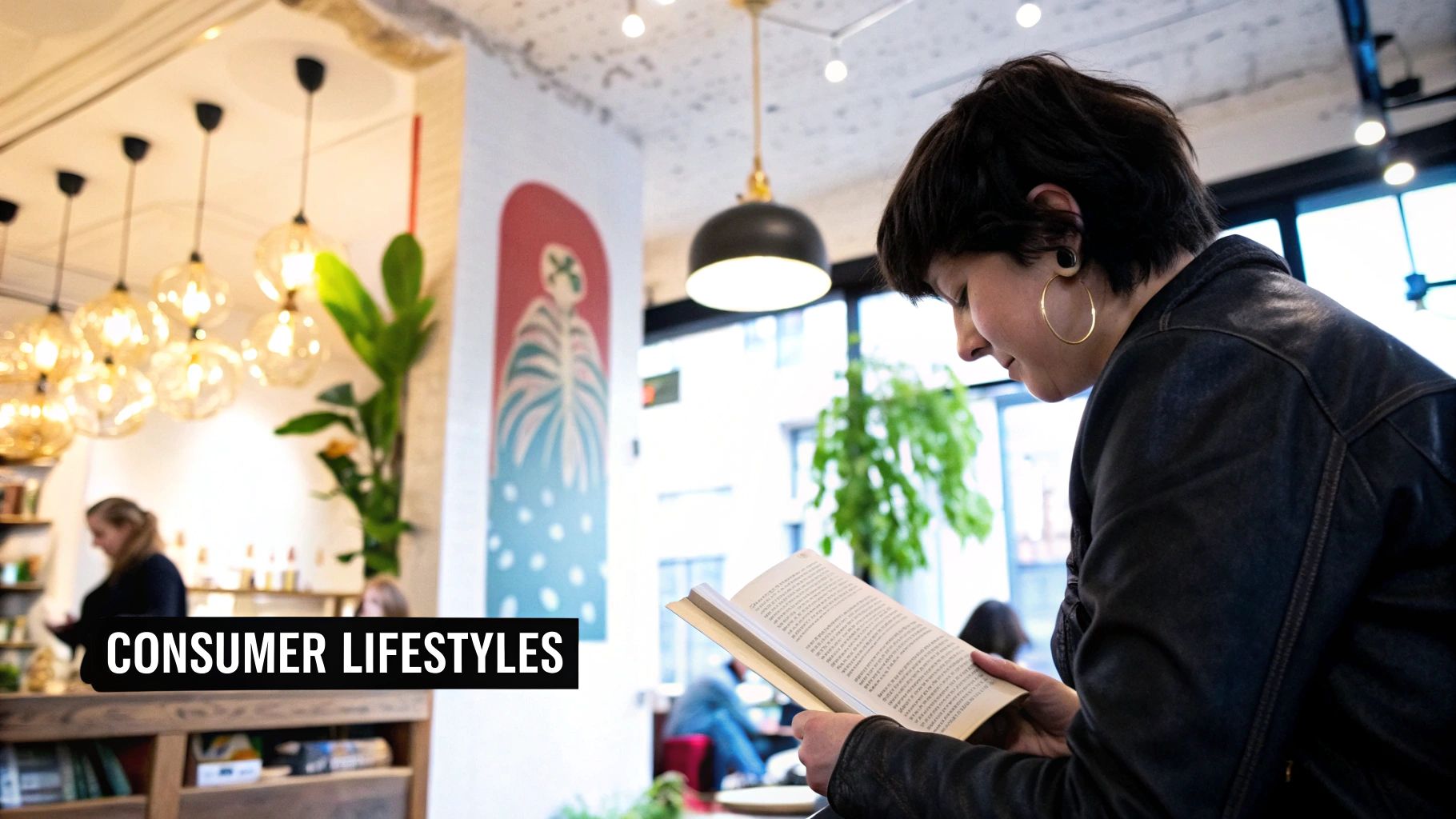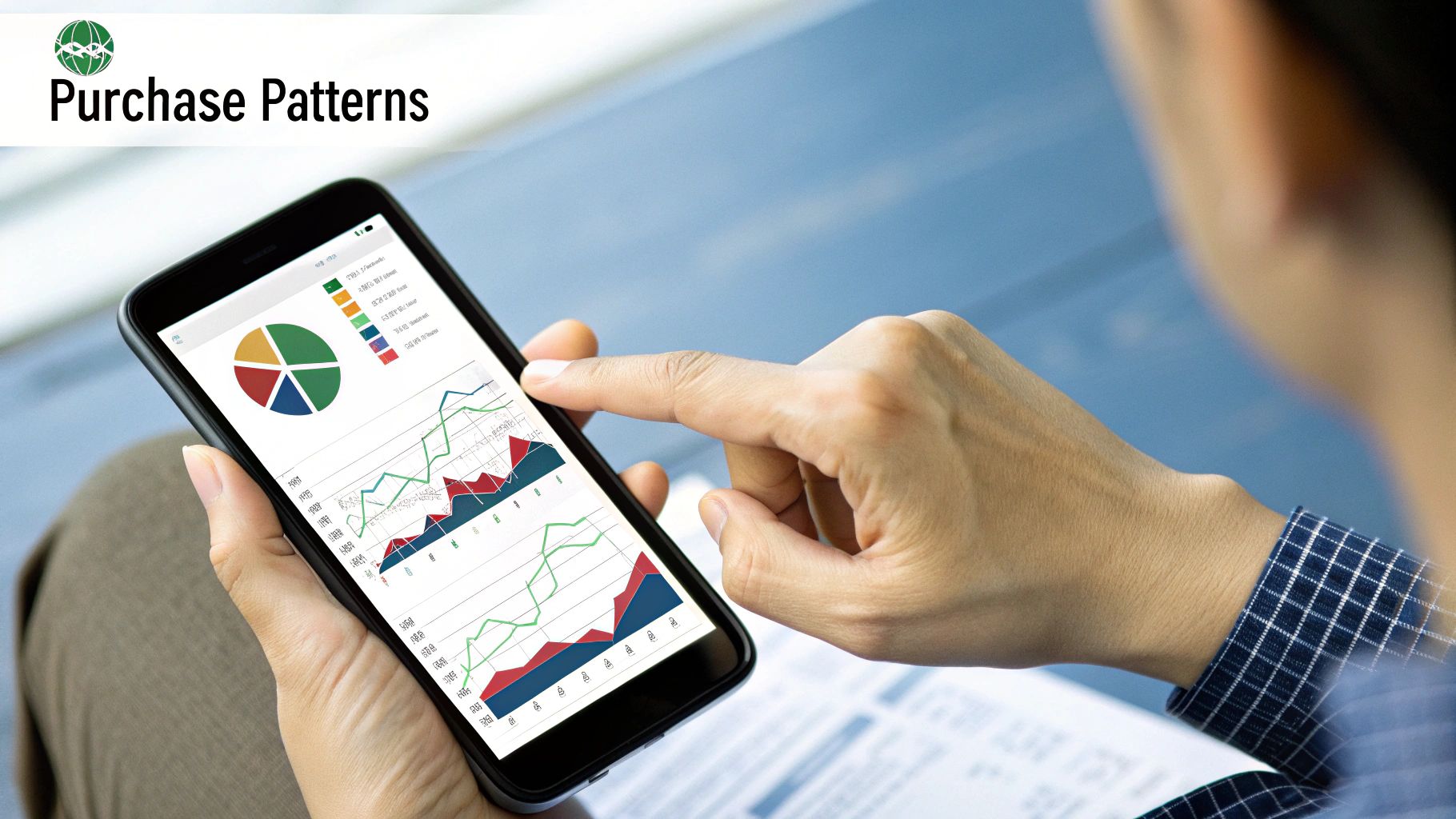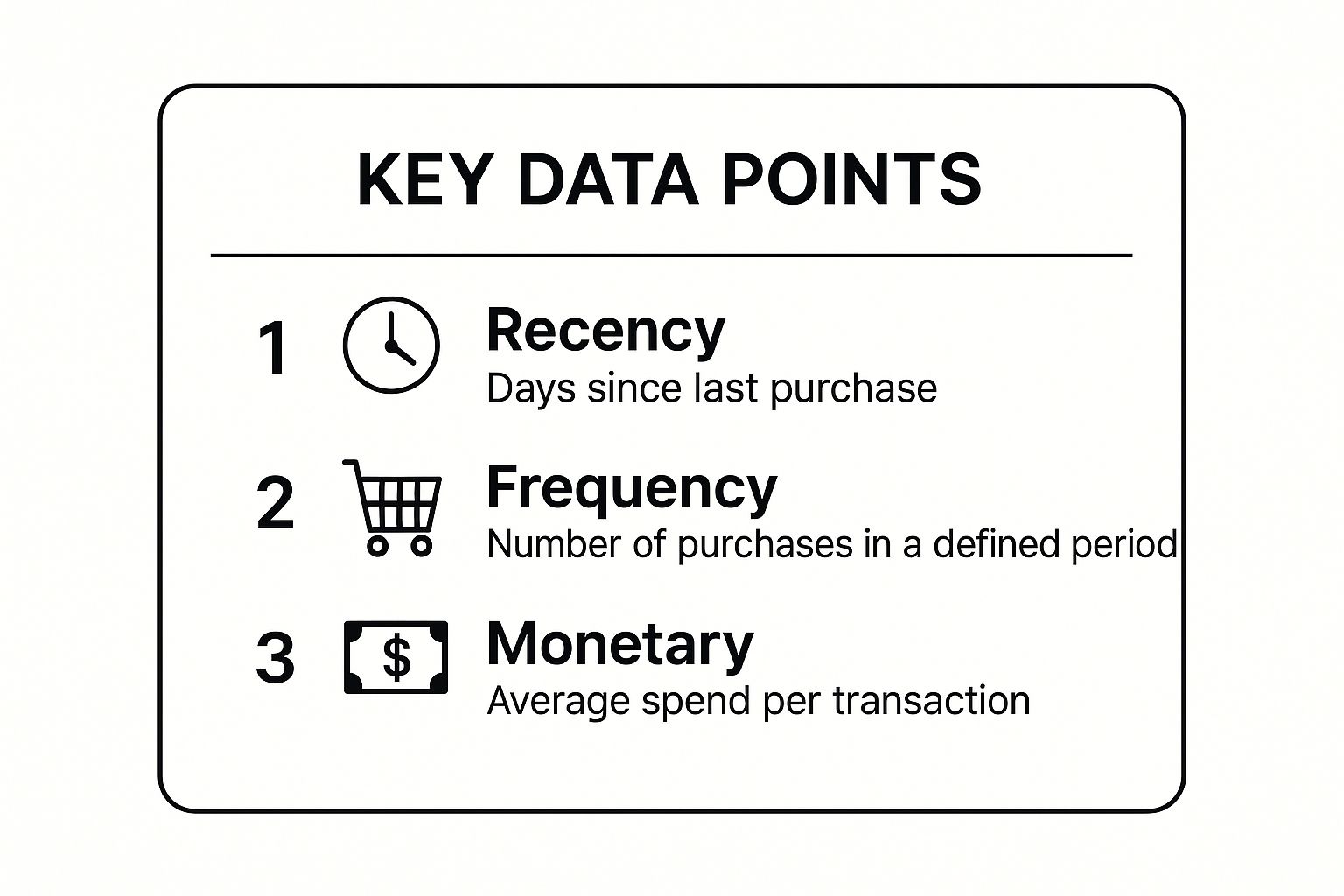Ever feel like you’re shouting into the void? You craft the perfect WhatsApp campaign, hit 'send,' and get… crickets. If your marketing feels like a lottery ticket, it’s probably because you're treating every customer the same. But consider this: segmented campaigns can drive up to a 760% increase in revenue, according to data from Campaign Monitor. The difference between a message that gets ignored and one that drives a sale isn't a bigger discount—it's relevance.
From our experience with over 500 Shopify stores, generic marketing is dead. The brands winning today are the ones who understand their audience on a deeper level. They're not just selling products; they're solving specific problems for specific groups of people. The key is mastering customer segmentation techniques.
In this playbook, you'll learn exactly how to identify your best customers, re-engage at-risk shoppers, and personalize every message for maximum impact. We'll provide actionable steps and real-world examples to transform your WhatsApp messaging from random noise into a predictable, revenue-generating machine.
1. Demographic Segmentation: The Foundational Layer
Let's start with the basics. Demographic segmentation groups customers by objective traits like age, gender, geographic location, and income level. Think of it as the concrete foundation of your marketing house. It’s not the most exciting part, but it’s absolutely essential for building more complex strategies on top.
This technique won't tell you why someone buys, but it gives you a crucial starting point. For instance, a campaign for anti-aging skincare needs different language and visuals for a 25-year-old versus a 55-year-old. A common mistake we see is brands either ignoring this data or relying on outdated stereotypes. The goal isn't to make broad assumptions; it's to ensure your offers resonate on a basic level.
How to Implement This With Kanal
You can easily collect this data on WhatsApp without being intrusive. A simple, one-question flow in your welcome series is all it takes.
Example WhatsApp Flow:
- Trigger: New customer subscribes.
- Button 1: "Men's Apparel"
- Button 2: "Women's Apparel"
- Action: Based on the click, Kanal automatically adds a "Gender: Male" or "Gender: Female" tag to the customer's profile.
- Trigger: A customer makes their second purchase.
- Button 1: "Finding eco-friendly products"
- Button 2: "Staying on top of trends"
- Button 3: "Comfort and practicality"
- Action: Based on the click, Kanal automatically tags their profile with "Values: Eco-Conscious," "Interest: Trendy," or "Lifestyle: Practical."
- Trigger: Customer abandons their shopping cart (tracked automatically via Shopify).
- Button: "Complete My Order" (links directly to their cart)
- Action: This flow directly targets a high-intent behavior, recovering potentially lost revenue. We've seen clients recover up to 15% of abandoned carts with this simple flow.
- Segment: In Kanal, create a customer segment for all users with a shipping address in Southern California zip codes.
- Trigger: A major heatwave is forecast for the region.
- Button: "Shop Cooling Gear"
- Action: This proactive, location-aware approach turns a weather event into a relevant sales opportunity, making your WhatsApp message feel like a helpful, timely tip.
- Who are your champions that deserve VIP treatment?
- Who are promising new customers you need to nurture?
- Who are at-risk customers about to churn?
- Trigger: A customer is tagged as "RFM_Champion" in Kanal.
- Button 1: "Yes, show me!"
- Button 2: "No, thanks."
- Action: A click on "Yes, show me!" sends them a direct link to a private collection page. This makes your best customers feel seen and appreciated, reinforcing their loyalty.
- Trigger: A customer from your "High-CLV" segment makes a new purchase.
- Button: "Shop Now & Save 25%"
- Action: The button links to a pre-applied discount page, providing a seamless, premium experience that reinforces their VIP status.
- Trigger: A customer purchases a "Starter Skincare Kit."
- Button 1: "Fighting Acne"
- Button 2: "Reducing Wrinkles"
- Button 3: "Hydrating Dry Skin"
- Action: Kanal automatically tags the customer's profile with "Need: Acne-Control," "Need: Anti-Aging," or "Need: Hydration."
- Trigger: Order is delivered.
- Button 1: "A gift"
- Button 2: "For me!"
- Action: Tag the customer's profile in Kanal as "Occasion: Gifting" or "Occasion: Self-Care."
- Start with Behavior: Don't get overwhelmed. Begin by mastering behavioral segmentation. Create a simple flow in Kanal for customers who have viewed a product more than twice but haven't purchased. This is low-hanging fruit and a strategy we've seen consistently deliver a high ROAS.
- Layer for Precision: The magic happens when you combine models. "First-time buyers" is good. "First-time buyers who purchased from the 'New Arrivals' category in the last 30 days" is exponentially better.
- Let Automation Do the Work: Manually pulling lists is a recipe for burnout. Use Kanal to automatically tag and segment customers based on real-time actions, like cart abandonment or purchase frequency.
- Test and Learn: Your customer segments aren't static. Continuously monitor the performance of your segmented campaigns to refine your approach.
This simple interaction lets you send targeted promotions for new arrivals, instantly making your messaging more personal and effective.
2. Psychographic Segmentation: Understanding the 'Why'
If demographics are the 'who,' psychographics are the 'why.' This technique groups customers by their values, lifestyles, and interests. It moves beyond objective data to uncover what truly motivates a person to buy. This is how you transform a customer base into a community.
A brand like Patagonia doesn't just sell outdoor gear; it sells a lifestyle of environmental consciousness. Their marketing resonates with customers who share these values, creating a powerful emotional connection. The strategy that consistently delivers the best results for our clients is using psychographics to build authentic buyer personas.

Expert Tip: Don't guess your customers' values. Ask them directly. A common mistake we see is brands building marketing around aspirational values instead of real customer motivations. Use conversational quizzes to get honest answers.
How to Implement This With Kanal
Use a simple WhatsApp quiz to uncover these valuable insights. It feels less like a survey and more like a personalized consultation.
Example WhatsApp Flow:
Now you can notify the eco-conscious group about a new sustainable collection or send the trend-focused segment early access to new arrivals.
3. Behavioral Segmentation: Turning Actions into Insights
Behavioral segmentation is one of the most powerful customer segmentation techniques because it's based on what people do, not just who they are. This method groups customers based on their direct interactions with your brand: purchase history, browsing patterns, cart additions, and campaign engagement.

Past behavior is the best predictor of future action. Knowing a customer consistently buys a specific product category allows you to send them hyper-relevant alerts. A common mistake we see is brands only looking at purchase history. True behavioral segmentation includes micro-actions like adding items to a cart (even if abandoned) or viewing a specific product multiple times. These are strong buying signals you can’t afford to ignore. Learn more about how behavioral targeting can transform your marketing on getkanal.com.
How to Implement This With Kanal
Kanal’s deep integration with Shopify lets you automatically track and act on customer behavior. One of the most critical actions to track is cart abandonment—a signal of high purchase intent.
Example WhatsApp Flow:
4. Geographic Segmentation: Making Your Marketing Local
Geographic segmentation divides your audience by location, such as country, city, or even climate. A customer’s needs and buying habits are often shaped by their local environment. This is one of the most practical customer segmentation techniques for optimizing logistics and messaging.
For instance, a fashion brand wouldn't promote winter coats to customers in Miami in July. From our experience, even subtle regional adaptations, like acknowledging a local holiday or offering location-specific shipping deals, can significantly lift conversion rates.
Expert Tip: Don't stop at the country level. A common mistake we see is brands targeting "USA" as one big group. Get granular. Target "California during a heatwave" or "New York City during a snowstorm." This precision shows customers you understand their immediate context, building incredible trust.
How to Implement This With Kanal
Use the shipping address data you already collect at checkout. No extra questions needed.
Example WhatsApp Flow:
5. RFM Analysis: Identifying Your Best Customers
RFM analysis is your blueprint for identifying your most valuable customers. This technique segments users based on three simple data points: Recency (how recently they bought), Frequency (how often they buy), and Monetary value (how much they spend). It helps you focus your efforts where they will generate the highest return.
RFM answers critical questions:
A customer with high scores across the board is a perfect candidate for a loyalty program, while one with high recency but low frequency might need a nudge to make their second purchase.

How to Implement This With Kanal
Once you've calculated RFM scores from your Shopify data, you can import those segments into Kanal using tags. This unlocks powerful, automated communication strategies.
Example WhatsApp Flow (for your "Champions" segment):
6. Value-Based Segmentation: Focusing on Profitability
Value-based segmentation groups customers based on their total economic worth to your business. It asks a crucial question: which customers are the most profitable? This model considers factors like Customer Lifetime Value (CLV), purchase frequency, and the cost to serve each customer.
A common mistake we see is focusing only on revenue. A high-revenue customer who frequently returns items and ties up your support team might be less valuable than one who buys less but is low-maintenance. This is why you need to learn how to calculate Customer Lifetime Value. We've seen clients use this to create tiered VIP programs, like offering free express shipping only to their top 5% most profitable customers. This protects margins while rewarding the best relationships.
How to Implement This With Kanal
Use Kanal to deliver exclusive perks to your highest-value customers, encouraging the behaviors that make them so profitable.
Example WhatsApp Flow:
7. Needs-Based Segmentation: Solving the Customer's "Job-to-be-Done"
This is where segmentation gets really powerful. Needs-based segmentation focuses on why customers buy. It groups people based on the specific job, problem, or need they are trying to solve with your product. A customer buying a protein shake might have a need for "post-workout recovery" or "a quick meal replacement." Each need requires completely different messaging.
Expert Tip: A common mistake we see is brands focusing too much on product features. Don't sell the mattress; sell a good night's sleep. Don't sell the running shoes; sell the feeling of hitting a new personal best. This shift in perspective is key to creating truly resonant marketing and powerful customer loyalty programs.
How to Implement This With Kanal
Uncover customer needs directly through a simple, conversational quiz on WhatsApp.
Example WhatsApp Flow:
This equips you to send highly relevant content and upsell the perfect next product, building a relationship based on understanding their goals.
8. Occasion-Based Segmentation: Capturing Contextual Intent
This technique focuses on when customers buy. Occasion-based segmentation groups customers by specific moments or events, recognizing that the same person buys for different reasons at different times. A customer buying flowers for Valentine's Day has different needs (urgency, higher budget) than someone buying flowers for their home.
A sports drink brand, for instance, should market differently to someone at the gym (focus on performance) versus someone recovering from being sick (focus on hydration). Understanding the occasion is your key to unlocking hyper-relevance.
How to Implement This With Kanal
Use a simple, post-purchase WhatsApp survey to uncover the purchase occasion.
Example WhatsApp Flow:
Now, leading up to the next major holiday, you can send a targeted campaign exclusively to your "Gifting" segment, knowing they are highly likely to be interested.
Ready to Turn These Techniques into Revenue?
We’ve just walked through a toolkit of powerful customer segmentation techniques. The common thread is a single, transformative idea: moving from broadcasting to conversing. Your customers aren't a monolith, and your marketing shouldn't treat them like one.
From our experience with high-growth Shopify stores, the brands that win are the ones who make their customers feel seen. They don't just blast discounts; they anticipate needs. This level of personalization isn't a "nice-to-have" anymore—it's the core of a resilient, profitable e-commerce strategy. A targeted WhatsApp message to a VIP customer boasts a 98% open rate and drives immediate sales. That's the power you unlock with segmentation.
Your Action Plan for Smarter Segmentation
Mastering these customer segmentation techniques is about building a more intelligent, responsive, and profitable business. You now have the blueprint; it's time to build.
Ready to stop guessing and start personalizing? Kanal, as an official Meta Business Partner, connects directly to your Shopify data, allowing you to build these powerful segments and automate high-engagement WhatsApp conversations in minutes. See how it works by installing Kanal on your Shopify store or booking a personalized demo with one of our e-commerce experts today.



